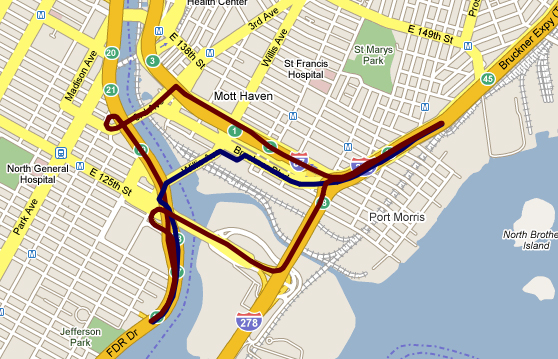Toll-Free Bridges Already “Tough” on South Bronx and Upper Manhattan
 The red lines show southbound routes through the South Bronx via the "free" Third Ave. Bridge and the tolled Triborough. The blue line charts the toll-free northbound route from the FDR across the Willis Avenue Bridge.
The red lines show southbound routes through the South Bronx via the "free" Third Ave. Bridge and the tolled Triborough. The blue line charts the toll-free northbound route from the FDR across the Willis Avenue Bridge.All the gnashing of teeth over East River bridge tolls has for the most part drowned out discussion of the Ravitch Commission’s proposal to charge motorists for Harlem River crossings as well. Though the tolls would be substantially lower — matching the (currently) $2 transit base fare — it’s still too much for two officials from the Bronx and Upper Manhattan.
From Thursday’s Daily News, reporting on Richard Ravitch’s testimony to state Assembly members:
At Wednesday’s hearing, Assemblymen Adriano Espaillat (D-Manhattan) and Carl Heastie (D-Bronx) worried about the impact tolls would have on constituents already struggling to make ends meet.
"As a legislator from the Bronx, you have to understand that the tolling of the bridges is a tough one," Heastie said.
Ravitch agreed, but said drivers would see significant improvements, including expanded bus service so they could consider ditching their cars, less traffic as drivers switch to mass transit and less pollution.
The commission also recommended discounts for drivers not crossing during rush hours, he said.
Not exactly fire-and-brimstone oratory from the Assemblymen, to be sure. Still, Espaillat and Heastie, both of whom backed congestion pricing, know that hundreds of thousands of their constituents are "already struggling to make ends meet" while paying up to $4 each workday for round-trip transit service — service that will suffer without new MTA revenue streams. Bronx Democratic boss Heastie must also know that "free" Harlem River bridges are an invitation to suburban drivers to trek through his borough.
After the jump, thoughts from a South Bronxite tipster on the plague of the toll-shoppers.
If you live in Connecticut or eastern Westchester County, and you want
to get to Manhattan, you would have to be an idiot to pay the $4.15 or
$5 Triborough toll. Every Fairfield County
resident knows that it is just as easy to take the free Third Avenue
Bridge into town and the free Willis Avenue Bridge back home.The only cost of their free ride is borne by the low-income,
minority communities of the South Bronx. East 135th Street might as
well be an interstate highway with traffic lights. If you stood for a while in the playground of P.S. 154, between
Alexander and Willis, or at the soot-stained ramp to the Third Avenue
Bridge, you’d see
more than a few toll-shopping Connecticut-plated vehicles.Why would Bronx politicians allow their borough to be the doormat
for wealthy Connecticut drivers? Not to mention, of course, that
over-reliance on the automobile was a major contributor to the 1970s and 80s depopulation of the Bronx, and the arson, crime and mayhem that
gave the borough a frightening reputation, spurring further
suburbanization and asthma-causing through traffic.
As for Upper Manhattan, Espaillat’s position is especially surprising, given his particularly outspoken support of pricing. Harlem River bridges have been all the rage on the Inwood and Washington Heights Livable Streets discussion board as of late, with members debating whether a $2 charge on the Broadway Bridge would "divide" Inwood or deter toll-averse motorists, locals and commuters alike, from clogging neighborhood streets.